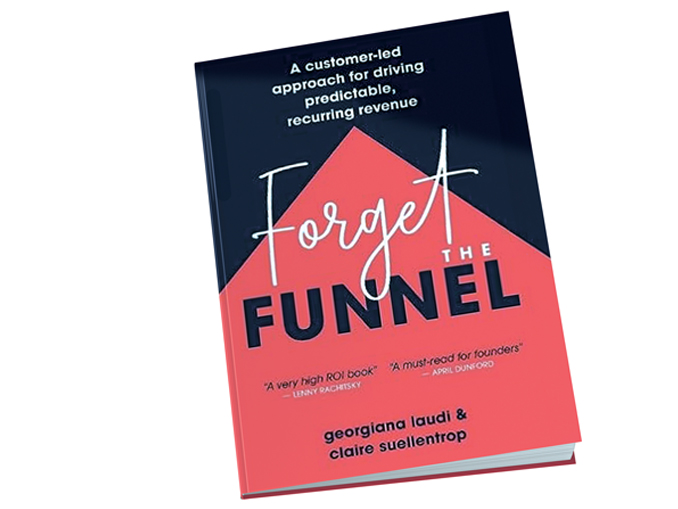 Reviewed by Jill Christ, UX & Growth Strategy Consultant, Glow Insights, Goleta, California, jill.glow.insights@gmail.com
Reviewed by Jill Christ, UX & Growth Strategy Consultant, Glow Insights, Goleta, California, jill.glow.insights@gmail.com
As a UX researcher, I’ve seen teams struggle to take action on customer insights and implement recommended changes. Pouring your heart and soul into gathering insights but seeing nothing come of it can be discouraging. In Forget the Funnel: A Customer-Led Approach for Driving Predictable, Recurring Revenue, authors Georgiana (Gia) Laudi and Claire Suellentrop set out to show a systematic process that takes the mystery out of turning customer research into marketing, product, and sales strategies that move key metrics for SaaS companies. After reading this book, I hope you agree that they achieved this.
Laudi and Suellentrop first do a wonderful job walking through which customer insights are most important to gather for growth-related projects. Using the jobs-to-be-done theory, they explain precisely how to gather and distill those insights into “job statements” that frame the essence of why customers decide to “hire” your product. While their focus is on SaaS software products, their approach can be applied to other products and services.
Knowing how challenging it can be to do research and turn it into actionable recommendations, I appreciate how Laudi and Suellentrop advocate for both gathering high-quality data and also dedicating time to distilling and boiling down your insights and framing them in a way that teams can remember and recognize. If you’ve ever felt mystified by this distilling process, you will be delighted to walk through Laudi and Suellentrop’s step-by-step approach. They have taken a process that might otherwise feel big or complicated and made it much more straightforward.
First, using surveys and interviews, Laudi and Suellentrop advocate for understanding the ideal customers’ journey. The best sample for this effort is a company’s ideal customers—those who understand the problem the product solves, have recently paid to use the product, and have solved the problem they wanted to solve with the product. The goal is to uncover what the person was struggling with before they learned about the product, what motivated them to try it, and what outcome they were hoping to achieve.
After gathering the insights, the next step is to parse the data. Each respondent’s struggles, motivations, and desired outcomes are labeled thematically, then filtered so you can “cut” your data by struggle. This allows you to look at the top motivations and desired outcomes associated with each struggle. These three attributes become the building blocks for crafting the “job statements.” It takes practice, but Laudi and Suellentrop outline every step of the process and include many practical tips.
Laudi and Suellentrop also break down how to envision your customers’ ideal experience based on the insights you gathered. By creating a customer journey map, you can envision how the customer ideally gets their “job” done using your product. This makes it very clear what actions, behaviors, and milestones customers go through in their journey. Again, Laudi and Suellentrop demonstrate how something as daunting as mapping out an experience and creating a strategic vision can actually be made clear and reproducible with a series of tangible steps.
Finally, Laudi and Suellentrop explain how to use the customer experience map to redefine what success looks like for your customers. Teams often make the mistake of defining success based on lagging indicators instead of defining success based on what customers value most. By mapping out the actions customers take when they are getting their job done, we can figure out the leading indicators of your customers’ success. You will find this useful if you have ever struggled to connect the dots between your research recommendations and the team’s goals.
Before I conclude, I do want to challenge one small point the authors make. In the beginning of the book, the authors argue that this process of gathering customer insights does not need to be “big, complicated, or expensive.” However, the value delivered is quite significant. Practitioners with a proven track record of driving predictable, recurring revenue using this method should certainly feel confident that the expense of their work matches what the results are worth. Or, at the very least, offer a money-back guarantee!



